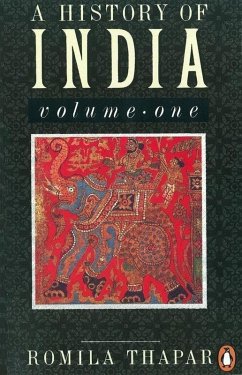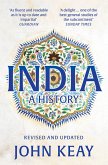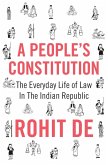Romila Thapar
A History of India (eBook, ePUB)
10,99 €
10,99 €
inkl. MwSt.
Sofort per Download lieferbar

0 °P sammeln
10,99 €
Als Download kaufen

10,99 €
inkl. MwSt.
Sofort per Download lieferbar

0 °P sammeln
Jetzt verschenken
Alle Infos zum eBook verschenken
10,99 €
inkl. MwSt.
Sofort per Download lieferbar
Alle Infos zum eBook verschenken

0 °P sammeln
Romila Thapar
A History of India (eBook, ePUB)
- Format: ePub
- Merkliste
- Auf die Merkliste
- Bewerten Bewerten
- Teilen
- Produkt teilen
- Produkterinnerung
- Produkterinnerung

Bitte loggen Sie sich zunächst in Ihr Kundenkonto ein oder registrieren Sie sich bei
bücher.de, um das eBook-Abo tolino select nutzen zu können.
Hier können Sie sich einloggen
Hier können Sie sich einloggen
Sie sind bereits eingeloggt. Klicken Sie auf 2. tolino select Abo, um fortzufahren.

Bitte loggen Sie sich zunächst in Ihr Kundenkonto ein oder registrieren Sie sich bei bücher.de, um das eBook-Abo tolino select nutzen zu können.
A history of India upto 1300 AD introducing the beginnings of India's cultural dynamics
- Geräte: eReader
- mit Kopierschutz
- eBook Hilfe
- Größe: 5.93MB
- FamilySharing(5)
Andere Kunden interessierten sich auch für
![India in the Persianate Age (eBook, ePUB) India in the Persianate Age (eBook, ePUB)]() Richard M. EatonIndia in the Persianate Age (eBook, ePUB)11,99 €
Richard M. EatonIndia in the Persianate Age (eBook, ePUB)11,99 €![The British in India (eBook, ePUB) The British in India (eBook, ePUB)]() David GilmourThe British in India (eBook, ePUB)10,99 €
David GilmourThe British in India (eBook, ePUB)10,99 €![The Penguin History of Modern Vietnam (eBook, ePUB) The Penguin History of Modern Vietnam (eBook, ePUB)]() Christopher GoschaThe Penguin History of Modern Vietnam (eBook, ePUB)12,99 €
Christopher GoschaThe Penguin History of Modern Vietnam (eBook, ePUB)12,99 €![Baghdad (eBook, ePUB) Baghdad (eBook, ePUB)]() Justin MarozziBaghdad (eBook, ePUB)9,49 €
Justin MarozziBaghdad (eBook, ePUB)9,49 €![Unruly Waters (eBook, ePUB) Unruly Waters (eBook, ePUB)]() Sunil AmrithUnruly Waters (eBook, ePUB)9,49 €
Sunil AmrithUnruly Waters (eBook, ePUB)9,49 €![India (eBook, ePUB) India (eBook, ePUB)]() John KeayIndia (eBook, ePUB)10,59 €
John KeayIndia (eBook, ePUB)10,59 €![A People's Constitution (eBook, ePUB) A People's Constitution (eBook, ePUB)]() Rohit DeA People's Constitution (eBook, ePUB)24,95 €
Rohit DeA People's Constitution (eBook, ePUB)24,95 €-
-
-
A history of India upto 1300 AD introducing the beginnings of India's cultural dynamics
Dieser Download kann aus rechtlichen Gründen nur mit Rechnungsadresse in A, B, BG, CY, CZ, D, DK, EW, E, FIN, F, GR, HR, H, IRL, I, LT, L, LR, M, NL, PL, P, R, S, SLO, SK ausgeliefert werden.
Produktdetails
- Produktdetails
- Verlag: Penguin Books Ltd
- Seitenzahl: 384
- Erscheinungstermin: 28. Juni 1990
- Englisch
- ISBN-13: 9780141949765
- Artikelnr.: 38127261
- Verlag: Penguin Books Ltd
- Seitenzahl: 384
- Erscheinungstermin: 28. Juni 1990
- Englisch
- ISBN-13: 9780141949765
- Artikelnr.: 38127261
- Herstellerkennzeichnung Die Herstellerinformationen sind derzeit nicht verfügbar.
Romila Thapar
Acknowledgements Preface 1. The Antecedents The discovery of India
changing approaches to Indian history
the archaeological background 2. The Impact of Aryan Culture Sources of evidence
The political organizations of the Aryan tribes
caste and other social institutions
Vedic relgion 3. Republics and Kingdoms c. 600-321 B.C. Evolving political patterns
the rise of the kingdom of Magadha
the rule of the Nandas
North-western India and contacts with Persia
the growth of towns
the rise of heterodox sects
Jainism and Buddhism 4. The Emergence of Empire 321-185 B.C. The Mauryan kings
Mauryan contacts with neighbouring states
society and economic activity
Mauryan administration
Ashoka and his policy of Dhamma
the decline of the Mauryan empire 5. The Disintegration of Empire c. 200 B.C.-A.D. 300 The political fragmentation of the sub-continent: the Shunga dynasty, King Kharavela of Kalinga, The Indo-Greek kings, The Shakas, The Kushanas, The Satavhana dynasty, South Indian Kingdoms
trade routes and communications 6. The Rise of the Mercantile Community c. 200 B.C.-A.D.300 Guilds
Roman trade with south India
interation of Indian and Hellenic ideas in northern India
India's contacts with China and south-east Asia
changes in society
education and literature
Buddhist art and architecture
Mahayana Buddhism
developments in Hinduism
the coming of Christianity 7. The Evolution of the "Classical" Pattern c. A.D. 300-700 The rule of the Guptas
Hun invasions
some post-Gupta dynasties
the reign of Harsha
changing agrarian relations
trade
the pattern of living
education and learning
Hindu art and architecture
development in Buddhism
changes in Hinduism
philosophical schools
Indian contacts with China and south-east Asia 8. Conflict in the Southern Kingdoms c. A.D. 500-900 The Chalukya, Pallava, and Pandya conflicts
political organization and administration
the Agrarian system
the status of the brahman
the philosophy of Shankara
the growth of Tamil literature
the Tamil devotional cult
mural painting in the Deccan
temple architecture 9. The South in the Ascendant c. A.D. 900-1300 The rise of the Cholas
Chola administration
the village in the Chola economy
trade
the role of the temple in Chola society
the development of the languages of the peninsula
popular cults and sects
the philosophy of Ramanuja and Madhva
architecture and sculpture 10. The Beginnings of Regional States in Northern India c. A.D. 700-1200 Political struggle between the Rashtrakutas, Pratiharas, and Palas
the arrival of the Arabs in Sind
rise of new kingdoms
growth of Raiput power
campaigns of Mahmud of Ghazni
the Afghan army
Muhammad Ghuri 11. Feudalism in the Regional States c. A.D. 800-1200 Beginnings of regional loyalty
emerging pattern of agrarian relations
social structure
literature in Sanskrit and in the newly developing languages
temples and sculpture
changes in Hinduism, the devotional cult, and the Tantric sects
decline of Buddhism
the arrival of the Sufis 12. The Re-alignment of Regional Kingdoms c. A.D. 1200-1526 Source material on the Delhi Sultanate
the Slave dynasty and the Khalji dynasty
political organization
the Tughluq dynasty
relations between the rulers and the ruled
the Sayyid and Lodi dynasties
the kingdoms of Gujarat, Mewar, Marwar, and Bengal 13. Assimilation on Trial c. A.D. 1200-1526 Trends in the impact of Islam on India
balance of power between king and theologian
administrative structure of the Sultanate
the economy
the social framework
religious expression as seen in the Bhakti movement and the Sufis
new languages and literatures
miniature painting
Islamic architecture >/b> The rise of the Vijayanagara and Bahmani kingdoms in the Deccan
changes in the socio-economic background
trade
religion Chronological table Glossary References to quotations General bibliography Bibliographical note on sources Index
changing approaches to Indian history
the archaeological background 2. The Impact of Aryan Culture Sources of evidence
The political organizations of the Aryan tribes
caste and other social institutions
Vedic relgion 3. Republics and Kingdoms c. 600-321 B.C. Evolving political patterns
the rise of the kingdom of Magadha
the rule of the Nandas
North-western India and contacts with Persia
the growth of towns
the rise of heterodox sects
Jainism and Buddhism 4. The Emergence of Empire 321-185 B.C. The Mauryan kings
Mauryan contacts with neighbouring states
society and economic activity
Mauryan administration
Ashoka and his policy of Dhamma
the decline of the Mauryan empire 5. The Disintegration of Empire c. 200 B.C.-A.D. 300 The political fragmentation of the sub-continent: the Shunga dynasty, King Kharavela of Kalinga, The Indo-Greek kings, The Shakas, The Kushanas, The Satavhana dynasty, South Indian Kingdoms
trade routes and communications 6. The Rise of the Mercantile Community c. 200 B.C.-A.D.300 Guilds
Roman trade with south India
interation of Indian and Hellenic ideas in northern India
India's contacts with China and south-east Asia
changes in society
education and literature
Buddhist art and architecture
Mahayana Buddhism
developments in Hinduism
the coming of Christianity 7. The Evolution of the "Classical" Pattern c. A.D. 300-700 The rule of the Guptas
Hun invasions
some post-Gupta dynasties
the reign of Harsha
changing agrarian relations
trade
the pattern of living
education and learning
Hindu art and architecture
development in Buddhism
changes in Hinduism
philosophical schools
Indian contacts with China and south-east Asia 8. Conflict in the Southern Kingdoms c. A.D. 500-900 The Chalukya, Pallava, and Pandya conflicts
political organization and administration
the Agrarian system
the status of the brahman
the philosophy of Shankara
the growth of Tamil literature
the Tamil devotional cult
mural painting in the Deccan
temple architecture 9. The South in the Ascendant c. A.D. 900-1300 The rise of the Cholas
Chola administration
the village in the Chola economy
trade
the role of the temple in Chola society
the development of the languages of the peninsula
popular cults and sects
the philosophy of Ramanuja and Madhva
architecture and sculpture 10. The Beginnings of Regional States in Northern India c. A.D. 700-1200 Political struggle between the Rashtrakutas, Pratiharas, and Palas
the arrival of the Arabs in Sind
rise of new kingdoms
growth of Raiput power
campaigns of Mahmud of Ghazni
the Afghan army
Muhammad Ghuri 11. Feudalism in the Regional States c. A.D. 800-1200 Beginnings of regional loyalty
emerging pattern of agrarian relations
social structure
literature in Sanskrit and in the newly developing languages
temples and sculpture
changes in Hinduism, the devotional cult, and the Tantric sects
decline of Buddhism
the arrival of the Sufis 12. The Re-alignment of Regional Kingdoms c. A.D. 1200-1526 Source material on the Delhi Sultanate
the Slave dynasty and the Khalji dynasty
political organization
the Tughluq dynasty
relations between the rulers and the ruled
the Sayyid and Lodi dynasties
the kingdoms of Gujarat, Mewar, Marwar, and Bengal 13. Assimilation on Trial c. A.D. 1200-1526 Trends in the impact of Islam on India
balance of power between king and theologian
administrative structure of the Sultanate
the economy
the social framework
religious expression as seen in the Bhakti movement and the Sufis
new languages and literatures
miniature painting
Islamic architecture >/b> The rise of the Vijayanagara and Bahmani kingdoms in the Deccan
changes in the socio-economic background
trade
religion Chronological table Glossary References to quotations General bibliography Bibliographical note on sources Index
Acknowledgements Preface 1. The Antecedents The discovery of India
changing approaches to Indian history
the archaeological background 2. The Impact of Aryan Culture Sources of evidence
The political organizations of the Aryan tribes
caste and other social institutions
Vedic relgion 3. Republics and Kingdoms c. 600-321 B.C. Evolving political patterns
the rise of the kingdom of Magadha
the rule of the Nandas
North-western India and contacts with Persia
the growth of towns
the rise of heterodox sects
Jainism and Buddhism 4. The Emergence of Empire 321-185 B.C. The Mauryan kings
Mauryan contacts with neighbouring states
society and economic activity
Mauryan administration
Ashoka and his policy of Dhamma
the decline of the Mauryan empire 5. The Disintegration of Empire c. 200 B.C.-A.D. 300 The political fragmentation of the sub-continent: the Shunga dynasty, King Kharavela of Kalinga, The Indo-Greek kings, The Shakas, The Kushanas, The Satavhana dynasty, South Indian Kingdoms
trade routes and communications 6. The Rise of the Mercantile Community c. 200 B.C.-A.D.300 Guilds
Roman trade with south India
interation of Indian and Hellenic ideas in northern India
India's contacts with China and south-east Asia
changes in society
education and literature
Buddhist art and architecture
Mahayana Buddhism
developments in Hinduism
the coming of Christianity 7. The Evolution of the "Classical" Pattern c. A.D. 300-700 The rule of the Guptas
Hun invasions
some post-Gupta dynasties
the reign of Harsha
changing agrarian relations
trade
the pattern of living
education and learning
Hindu art and architecture
development in Buddhism
changes in Hinduism
philosophical schools
Indian contacts with China and south-east Asia 8. Conflict in the Southern Kingdoms c. A.D. 500-900 The Chalukya, Pallava, and Pandya conflicts
political organization and administration
the Agrarian system
the status of the brahman
the philosophy of Shankara
the growth of Tamil literature
the Tamil devotional cult
mural painting in the Deccan
temple architecture 9. The South in the Ascendant c. A.D. 900-1300 The rise of the Cholas
Chola administration
the village in the Chola economy
trade
the role of the temple in Chola society
the development of the languages of the peninsula
popular cults and sects
the philosophy of Ramanuja and Madhva
architecture and sculpture 10. The Beginnings of Regional States in Northern India c. A.D. 700-1200 Political struggle between the Rashtrakutas, Pratiharas, and Palas
the arrival of the Arabs in Sind
rise of new kingdoms
growth of Raiput power
campaigns of Mahmud of Ghazni
the Afghan army
Muhammad Ghuri 11. Feudalism in the Regional States c. A.D. 800-1200 Beginnings of regional loyalty
emerging pattern of agrarian relations
social structure
literature in Sanskrit and in the newly developing languages
temples and sculpture
changes in Hinduism, the devotional cult, and the Tantric sects
decline of Buddhism
the arrival of the Sufis 12. The Re-alignment of Regional Kingdoms c. A.D. 1200-1526 Source material on the Delhi Sultanate
the Slave dynasty and the Khalji dynasty
political organization
the Tughluq dynasty
relations between the rulers and the ruled
the Sayyid and Lodi dynasties
the kingdoms of Gujarat, Mewar, Marwar, and Bengal 13. Assimilation on Trial c. A.D. 1200-1526 Trends in the impact of Islam on India
balance of power between king and theologian
administrative structure of the Sultanate
the economy
the social framework
religious expression as seen in the Bhakti movement and the Sufis
new languages and literatures
miniature painting
Islamic architecture >/b> The rise of the Vijayanagara and Bahmani kingdoms in the Deccan
changes in the socio-economic background
trade
religion Chronological table Glossary References to quotations General bibliography Bibliographical note on sources Index
changing approaches to Indian history
the archaeological background 2. The Impact of Aryan Culture Sources of evidence
The political organizations of the Aryan tribes
caste and other social institutions
Vedic relgion 3. Republics and Kingdoms c. 600-321 B.C. Evolving political patterns
the rise of the kingdom of Magadha
the rule of the Nandas
North-western India and contacts with Persia
the growth of towns
the rise of heterodox sects
Jainism and Buddhism 4. The Emergence of Empire 321-185 B.C. The Mauryan kings
Mauryan contacts with neighbouring states
society and economic activity
Mauryan administration
Ashoka and his policy of Dhamma
the decline of the Mauryan empire 5. The Disintegration of Empire c. 200 B.C.-A.D. 300 The political fragmentation of the sub-continent: the Shunga dynasty, King Kharavela of Kalinga, The Indo-Greek kings, The Shakas, The Kushanas, The Satavhana dynasty, South Indian Kingdoms
trade routes and communications 6. The Rise of the Mercantile Community c. 200 B.C.-A.D.300 Guilds
Roman trade with south India
interation of Indian and Hellenic ideas in northern India
India's contacts with China and south-east Asia
changes in society
education and literature
Buddhist art and architecture
Mahayana Buddhism
developments in Hinduism
the coming of Christianity 7. The Evolution of the "Classical" Pattern c. A.D. 300-700 The rule of the Guptas
Hun invasions
some post-Gupta dynasties
the reign of Harsha
changing agrarian relations
trade
the pattern of living
education and learning
Hindu art and architecture
development in Buddhism
changes in Hinduism
philosophical schools
Indian contacts with China and south-east Asia 8. Conflict in the Southern Kingdoms c. A.D. 500-900 The Chalukya, Pallava, and Pandya conflicts
political organization and administration
the Agrarian system
the status of the brahman
the philosophy of Shankara
the growth of Tamil literature
the Tamil devotional cult
mural painting in the Deccan
temple architecture 9. The South in the Ascendant c. A.D. 900-1300 The rise of the Cholas
Chola administration
the village in the Chola economy
trade
the role of the temple in Chola society
the development of the languages of the peninsula
popular cults and sects
the philosophy of Ramanuja and Madhva
architecture and sculpture 10. The Beginnings of Regional States in Northern India c. A.D. 700-1200 Political struggle between the Rashtrakutas, Pratiharas, and Palas
the arrival of the Arabs in Sind
rise of new kingdoms
growth of Raiput power
campaigns of Mahmud of Ghazni
the Afghan army
Muhammad Ghuri 11. Feudalism in the Regional States c. A.D. 800-1200 Beginnings of regional loyalty
emerging pattern of agrarian relations
social structure
literature in Sanskrit and in the newly developing languages
temples and sculpture
changes in Hinduism, the devotional cult, and the Tantric sects
decline of Buddhism
the arrival of the Sufis 12. The Re-alignment of Regional Kingdoms c. A.D. 1200-1526 Source material on the Delhi Sultanate
the Slave dynasty and the Khalji dynasty
political organization
the Tughluq dynasty
relations between the rulers and the ruled
the Sayyid and Lodi dynasties
the kingdoms of Gujarat, Mewar, Marwar, and Bengal 13. Assimilation on Trial c. A.D. 1200-1526 Trends in the impact of Islam on India
balance of power between king and theologian
administrative structure of the Sultanate
the economy
the social framework
religious expression as seen in the Bhakti movement and the Sufis
new languages and literatures
miniature painting
Islamic architecture >/b> The rise of the Vijayanagara and Bahmani kingdoms in the Deccan
changes in the socio-economic background
trade
religion Chronological table Glossary References to quotations General bibliography Bibliographical note on sources Index







